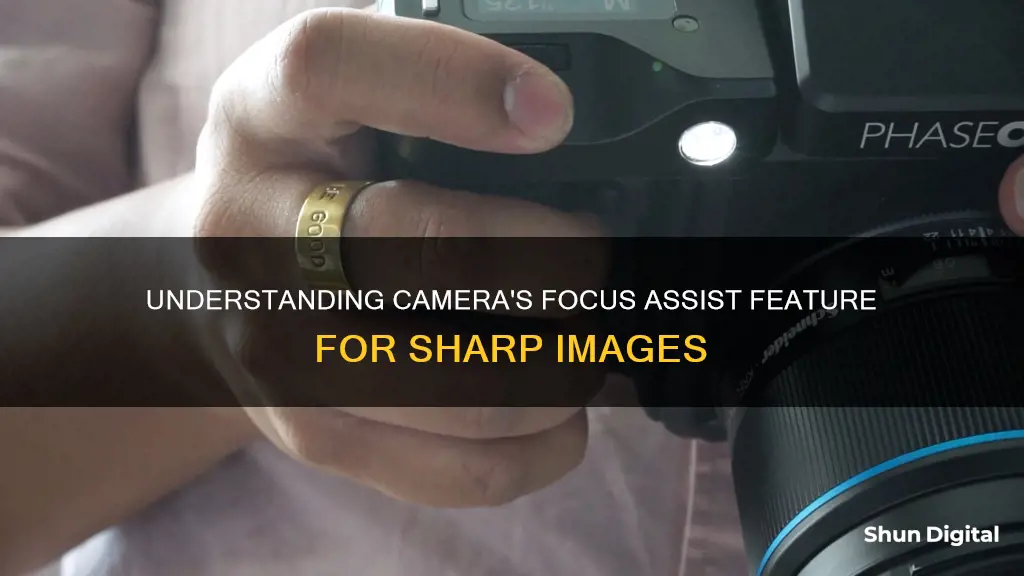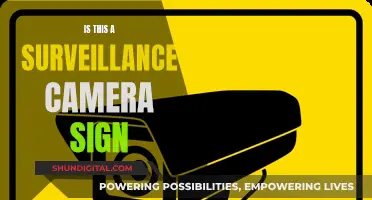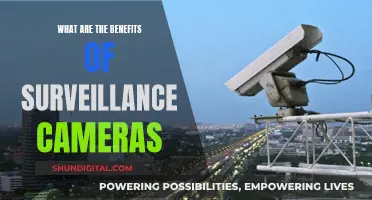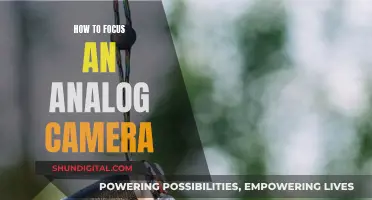
Focus assist is a camera feature that helps users focus on their desired target. It is particularly useful in low-light conditions or when there is a lack of autofocus. The function works by illuminating the subject with a lamp or flash, or by expanding the centre of the screen to allow users to bring the image into focus more easily. Some cameras also have a focus bar display, which indicates the degree of focus through the length of a bar.
| Characteristics | Values |
|---|---|
| Purpose | To assist with autofocus in low light or darkness |
| Light type | Normal or infrared |
| Lamp | Visible or invisible |
| Autofocus | Focuses on the centre of the image area |
| Manual focus | Magnifies the image to allow focus checking |
| Peaking highlights | Displayed in white, yellow or red |
| Display | Expanded display is available in the viewfinder |
What You'll Learn

Focus assist in low-light settings
Focus assist is a feature that helps your camera focus in low-light settings. It is available in two types: visible and invisible (infrared). The AF assist beam, as it is called, provides just enough red light for the camera's autofocus system to lock onto the subject. This is called "Active Autofocus" and it works by measuring the distance between the camera and the subject.
To make this work, you will need a modern speedlight or a flash commander that has a built-in “AF assist” red beam. Many Nikon speedlights like SB-600, SB-700, SB-800, SB-900, and SB-910 come with AF-assist capability, so any of those should work. The Nikon SU-800 flash commander will also work (as long as you don't need flash on your camera).
- Mount a speedlight or a commander on your DSLR camera’s hot shoe.
- Change your focus mode to AF-S (Single Servo / Single Area AF).
- Half-press the shutter release or the AF-ON button and you should see the red lights on the speedlight activate.
- A red beam will be projected onto your subject, which will allow your lens to immediately acquire focus.
It is important to note that the AF assist beam only works on subjects within a close range of 15-20 feet. Additionally, you need to make sure you’re on single or one-shot focus modes, as it’s not suitable for moving subjects.
If you prefer not to use flash, you can still achieve autofocus in low-light settings by using an external autofocus assist device or by manually focusing with the help of an additional light source.
Best Battery-Powered Cameras: Uninterrupted Photography
You may want to see also

Focus assist lamp
An AF (autofocus) assist lamp is a small light, usually built into the camera body above the lens mount. It assists the camera in focusing on a subject in low-light conditions by lighting up the subject while the camera focuses. The AF assist lamp only works at very short distances due to its low-power output. It is important that the lamp is only lit while the camera is focusing; if it remains on while the camera is metering an image, the camera may read the scene as brighter than it is, leading to unwanted underexposure.
AF assist lamps are particularly useful in low-light conditions, such as wedding receptions, where it can be challenging to get an accurate focus, especially when people are moving or dancing. However, using the built-in camera AF illumination lamp can be harsh and distracting. In such situations, it is recommended to use a flash that provides good autofocus-assist capabilities.
Most Nikon digital SLR cameras have a focus assist light that illuminates when the shutter button is pressed halfway down to focus. This feature can be turned on or off in the custom settings of the camera's menu.
It is worth noting that some cameras do not have a dedicated autofocus assist lamp. Instead, they use their built-in flash, illuminating the subject with stroboscopic bursts of light. While this assists the autofocus system, it can have the disadvantage of startling or annoying living subjects.
Ronin S Camera Focus: Mastering the Art of Stabilization
You may want to see also

Focus assist for Live View
Focus assist is a feature on some cameras that helps the autofocus work in low-light or completely dark conditions. The camera emits a normal or infrared light to illuminate the subject, allowing the autofocus to work.
Focus peaking was initially used by videographers but has since been adopted by still photographers thanks to technological advances. It is now widely available in most digital cameras, and all newer mirrorless cameras come with this function. If you have a DSLR camera, it may be called Focus Assist for Live View.
Focus peaking works by detecting the edges of highest contrast in your scene (and therefore what is most in focus) and highlighting them in a bright colour, usually of your choice. The camera will typically use red, blue, green, white, or yellow, which will stand out against the normal colours of the scene. This feature can also help you see how much of the scene is in focus at certain apertures, allowing you to check your current depth of field.
Focus peaking allows photographers to focus manual lenses faster than the typical Live View method. It's also useful if you don't want to use autofocus to capture slow-moving objects, like clouds in the sky. With focus peaking, you can find the proper depth of field for your shots, but you must pay attention to your adjustments, including your ISO.
Dummy Battery Camera: What's the Deal?
You may want to see also

Focus assist for manual lenses
Manual focus lenses are a great way to merge film techniques with digital tools, and they can be a more affordable option for photographers. However, using them with modern cameras can be challenging due to the lack of electrical connectivity and the need for mount adapters.
Cost and Characteristics
Manual focus lenses can be a more affordable option for photographers, with good lenses available at a fraction of the cost of modern autofocus lenses. They can also provide unique characteristics to your photography, with each lens rendering a scene differently in terms of colour rendition, sharpness, and bokeh.
Metering and Camera Modes
One challenge of using manual focus lenses is that they require stop-down metering. This process involves setting the aperture to the widest available, focusing the lens, and then changing the aperture to the desired setting. This can make the viewfinder dim and limit the camera modes that can be used effectively.
Focus Confirmation and Focusing Screens
Another issue is that modern DSLRs are designed for autofocus, and their focusing screens may not be as effective for manual focus lenses. Additionally, some focus confirmation systems do not work well with manual focus lenses, making it difficult to nail focus quickly.
Mount Adapters
To use manual focus lenses with modern cameras, you may need a mount adapter. These adapters increase the distance between the lens and the sensor, allowing for proper focus. However, they can degrade image quality and introduce a focal length multiplier. It's important to consider the flange focal distance and lens mount diameter when adapting lenses to ensure they will work effectively.
Tips for Using Manual Focus Lenses
- Utilise stop-down metering by setting the aperture to the widest available, focusing, and then adjusting to the desired aperture.
- Be prepared to use manual or aperture priority modes, as other creative modes may not function properly.
- Expect that your camera's recommended exposure may be too dark or light, and adjust accordingly using exposure compensation or manual adjustments.
- Consider upgrading your focusing screen to a split prism screen for more accurate manual focusing.
- Look for mount adapters that are compatible with your camera and lens mounts, ensuring the flange focal distance and lens mount diameter match.
- Practice using manual focus lenses to improve your focusing skills and nail finer focus that autofocus systems may struggle with.
GoPro Cameras: Which Models Offer the Longest Battery Life?
You may want to see also

Focus assist for web browsers
Focus assist is a feature in some cameras that helps with autofocusing on a subject, especially in low-light conditions or total darkness. It typically works by projecting a beam of light, either visible or infrared, onto the subject, allowing the autofocus sensors to detect and focus on it effectively. This is often referred to as an autofocus assist beam or AF assist beam.
Now, let's explore the concept of "Focus Assist for Web Browsers" and how it can be a valuable tool for users:
While the term "Focus Assist" is primarily associated with cameras, we can draw parallels to web browsers and how they can implement similar concepts to enhance the user experience. Modern web browsers have become sophisticated tools for consuming web content, and they can benefit from features that assist users in focusing on relevant information.
Highlighting Important Content:
Just as focus assist in cameras helps highlight the subject, web browsers can employ visual cues to draw users' attention to important content on a webpage. This can be achieved through subtle animations, colour-coding, or highlighting. For example, a browser extension could analyse a webpage and use subtle overlays to emphasise key paragraphs, headings, or links, making it easier for users to identify the most relevant information at a glance.
Reducing Visual Clutter:
Web pages often contain a plethora of elements, advertisements, and distractions that can hinder users' ability to focus. A "Focus Assist" mode in a web browser could simplify the page layout, minimising or removing non-essential elements to create a cleaner, more focused reading experience. This could be particularly useful for users with attention disorders or those seeking a more relaxed browsing experience.
Enhanced Search Functionality:
Web browsers could integrate advanced search features that go beyond simple keyword searches. With "Focus Assist", users could highlight a specific phrase or topic, and the browser would then visually emphasise all instances of related content on the page. This would assist users in quickly identifying relevant information, especially on lengthy or complex web pages.
Adaptive Reading Experience:
Taking a cue from cameras' autofocus capabilities, web browsers could utilise machine learning algorithms to offer an adaptive reading experience. By analysing user behaviour, such as time spent on pages, scrolling patterns, and click behaviour, the browser could suggest optimised font sizes, colour schemes, or layout adjustments to enhance focus and readability.
Focus Mode for Productivity:
Building upon existing focus-blocking features, web browsers could introduce a dedicated "Focus Mode". This mode could be triggered manually or based on user preferences, blocking specific websites or applications that might distract from the task at hand. It could also incorporate productivity-enhancing features, such as a to-do list, a timer, or a minimal writing interface, helping users stay focused and efficient during work or study sessions.
In conclusion, while the term "Focus Assist" might be predominantly associated with cameras, web browsers can adopt and adapt similar concepts to improve users' online experiences. By highlighting important content, reducing visual clutter, enhancing search functionality, offering adaptive reading experiences, and providing dedicated focus modes, web browsers can empower users to focus better and get the most out of their time online.
Making Pinhole Cameras: A Step-by-Step Guide
You may want to see also
Frequently asked questions
Focus assist is a function that helps the user to focus on a target easily. It is particularly useful in low-light conditions or when it is difficult to determine a good focus with the naked eye.
Focus assist uses a visible or invisible (infrared) lamp to illuminate the subject so that the autofocus can work in low light or total darkness.
Focus assist is a more general term for functions that help the user to focus on a target. Focus peaking is a specific type of focus assist that uses the camera's Live View focusing aid to highlight peak contrast areas with a false-colour overlay in your viewfinder.







